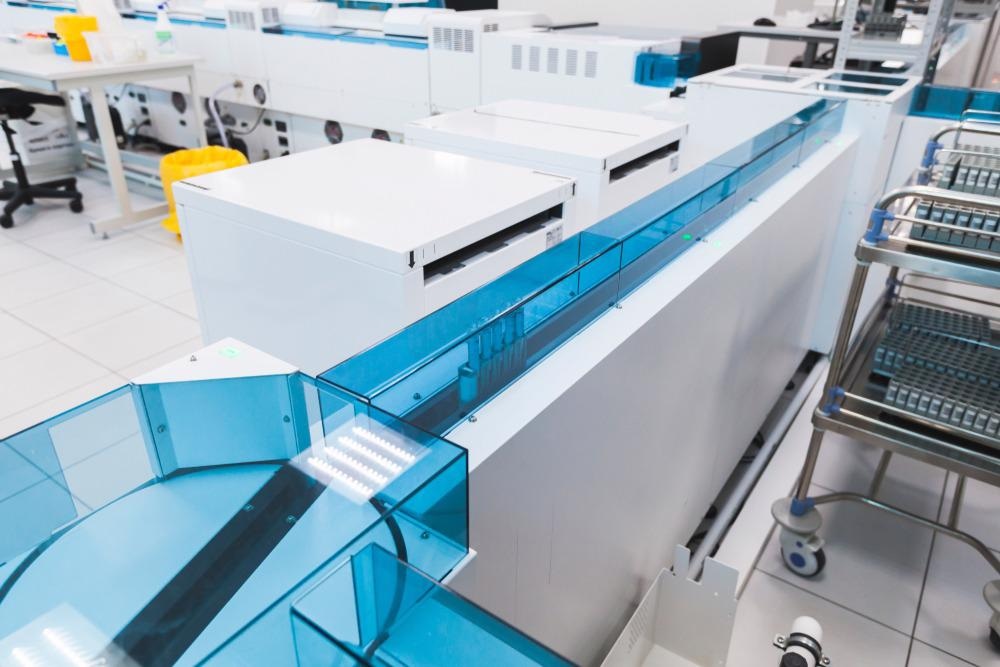Over recent years, automation has made a significant impact on the face of the healthcare sector. Advances in automation technology, often coupled with artificial intelligence (AI) and the Internet of Things (IoT) have been integrated into medical research, drug development, surgical processes, and, as we will discuss here, clinical diagnostics.

Image Credit: Evannovostro/Shutterstock.com
How automation is transforming medicine
Automation has been widely adopted in clinical laboratories to enhance accuracy and bring down costs. By their nature, automation systems eliminate the problem of human error, which can have significant costs in this field of medicine.
Automation systems can also bring down long-term costs of running various laboratory processes by reducing requirements for trained staff. Similarly, in substituting robotics for humans, automation can speed up laborious processes and enhance the accuracy of their execution, which not only improves the quality of laboratory processes but it further brings down the associated costs by reducing the time taken to conduct each task.
Leveraging automation in clinical laboratories has the potential to positively impact patient outcomes in many ways. The improvement and speeding up of clinical diagnostics is one area, in particular, that is helping to improve patient quality of life and enhance various clinical measures of patient survival.
The challenge of long wait times for diagnostic results
Long wait times for the results of diagnostic tests can negatively impact patient outcomes. Shortages of trained staff and limited resources that lead to bottlenecks in diagnostic labs have been shown to lead to poorer patient outcomes. Recent reports have revealed that patients in some regions have faced waiting times of months to get a diagnosis of cancer.
Given that early intervention is key in increasing survival chances and improving quality of life, long wait times for a diagnosis that delays the onset of treatment are having a negative impact on patient outcomes, and, in some cases may even be responsible for unnecessary deaths.
It is intolerable that patients should risk higher mortality rates due to long wait times. The medical sector has been challenged with adapting its processes to overcome staff and resource shortages to ensure that diagnostics can be run in a timely fashion. Automation and robotics may be the answer.
Diagnostic error is one of the healthcare industry’s leading problems
Recent data has estimated that around 10-20% of diagnoses made in the US are inaccurate, attributing to a potential 40,000-80,000 deaths each year from diagnostic errors.
In a review of 25 years of malpractice claim payouts made in the US, researchers at Johns Hopkins discovered that diagnostic errors were the most common cause of a claim being made, placing it above surgical mistakes and medication overdoes. Additionally, diagnostic errors were attributed to the highest levels of patient harm and accumulated the highest total of penalty payments - roughly $38.8 billion between 1986 and 2010.
As well as helping clinical diagnostics overcome the issue of long wait times, automation is also being leveraged to improve diagnostic accuracy.
Automation is overcoming challenges of clinical diagnostics
As discussed, the speed and accuracy of diagnostics are key for ensuring the quality of patient outcomes. Traditional laboratory techniques are often labor-intensive, requiring numerous skilled professionals and many hours of work. Additionally, the nature of the work of many conventional diagnostic analyses is monotonous. These factors lead to degrees of inaccuracy in results and long wait times when there is a lack of trained staff.
Automation removes the issue of needing human workers. It also removes the potential for human error. Mistakes made by automated systems, research shows, are far less frequent than error rates in humans.
In recent years, many diagnostic platforms that leverage automation have emerged. These systems use robotics, AI, and automation to perform tasks with minimal human input. As a result, diagnostic results are more accurate and achieved much faster.
Northwell's Brand-New Automated Clinical Laboratory
The future of automation in clinical diagnostics
Automation is already well established in the field of clinical diagnostics and it is expected to continue to grow in the coming years. The global laboratory automation systems market is predicted to be valued at around $5.2 billion in 2021, growing at a compound annual growth rate (CAGR) of 7.2% from 2020. By 2025 it is expected to reach a value of $6.4 billion, growing at a CAGR of 5.2% from 2021. The Covid-19 pandemic will be the main driver of this growth, with adaptations to restrictive containment measures, such as social distancing and remote working pushing the need to run operations with less staff, in a remotely operational fashion.
In the coming years, we will likely see further developments in clinical automation technology alongside wider adoption of this technology in hospitals worldwide. These changes will likely form part of a larger shift towards automation in healthcare that began before the pandemic but has been accelerated by the restrictions imposed to manage the spread of the SARS-Cov-2 virus.
Further Reading
Last Updated: Aug 16, 2023